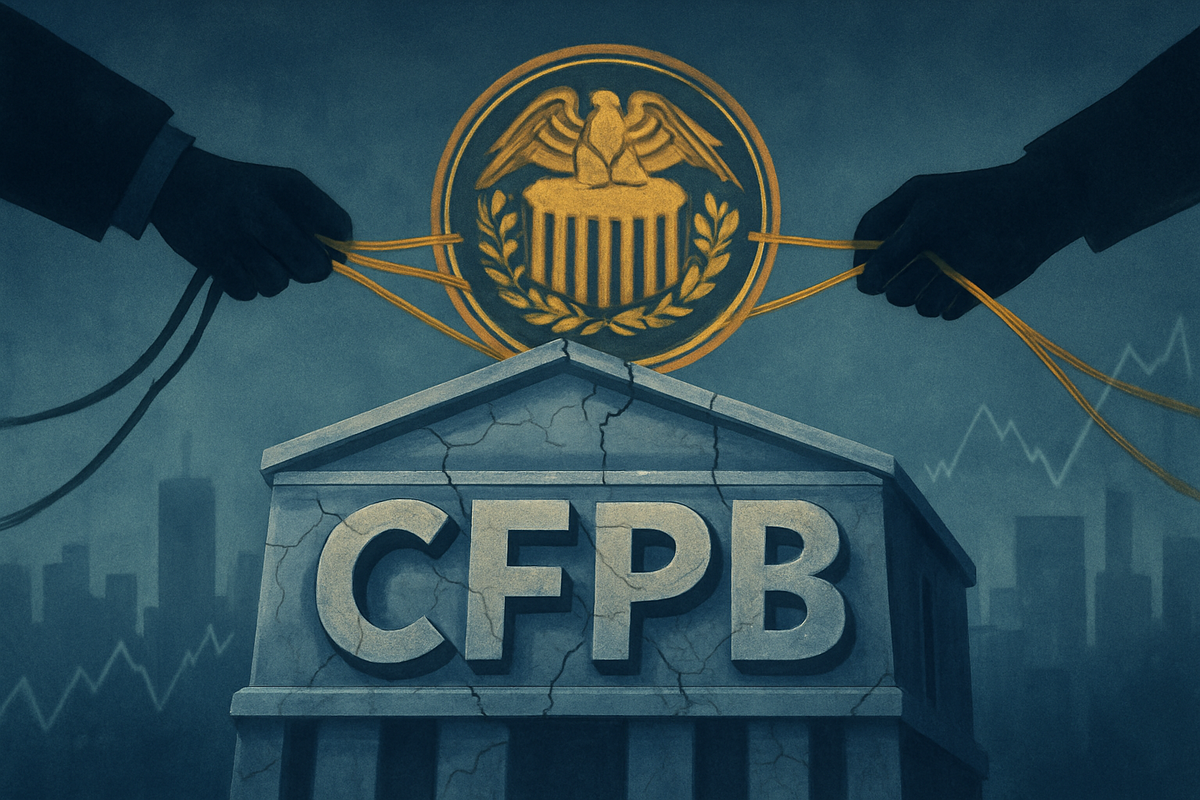
The Consumer Financial Protection Bureau (CFPB), a linchpin of American consumer financial safeguards, finds itself embroiled in a profound legal and political battle over its unique funding mechanism. While a landmark Supreme Court decision in May 2024 affirmed the constitutionality of the CFPB's funding directly from the Federal Reserve, subsequent aggressive actions by a new Trump administration, as of November 2025, have reignited the dispute, threatening the agency's operational independence and regulatory effectiveness. This renewed assault on the CFPB's financial autonomy could have far-reaching implications, reshaping the regulatory landscape for financial institutions and potentially diminishing protections for millions of American consumers.
The core of the conflict centers on whether the CFPB's ability to draw funds from the Federal Reserve, rather than relying on annual congressional appropriations, provides it with undue insulation from political oversight. Critics argue this structure grants the agency a "blank check," while proponents maintain it is essential for the CFPB to act as an impartial watchdog, free from partisan influence. As the current administration moves to drastically curtail the CFPB's budget and operations, the financial markets brace for a period of heightened uncertainty and a potential paradigm shift in consumer finance regulation.
A Legal Victory Followed by an Administrative Onslaught
The legal saga surrounding the CFPB's funding reached a critical juncture on May 16, 2024, when the U.S. Supreme Court, in a decisive 7-2 ruling in Consumer Financial Protection Bureau v. Community Financial Services Association of America, Limited (CFSA), upheld the constitutionality of the agency's funding mechanism. The Court, with Justice Clarence Thomas authoring the majority opinion, found that Congress's authorization for the CFPB to draw money from the Federal Reserve's earnings satisfied the Appropriations Clause of the U.S. Constitution. This decision reversed a 2022 ruling by the U.S. Court of Appeals for the Fifth Circuit, which had deemed the funding unconstitutional. The Supreme Court's verdict was widely seen as a significant victory for the CFPB, validating its structure and removing a major legal cloud that had hindered its regulatory and enforcement activities since its inception.
However, this judicial affirmation proved to be a fleeting triumph. As of November 2025, under a new Trump administration, the CFPB faces an existential threat from executive actions. The administration's Justice Department's Office of Legal Counsel (OLC) has issued a controversial legal opinion asserting that the CFPB cannot legally request new funds from the Federal Reserve. This interpretation hinges on the argument that the Dodd-Frank Act's provision allowing the CFPB to draw from the "combined earnings" of the Federal Reserve System refers specifically to profits. Since the Federal Reserve has been operating at a loss since 2022, the OLC contends there are no legal funds for the CFPB to draw upon.
Russell Vought, appointed as the Acting Director of the CFPB by the Trump administration, has been central to these efforts. Reports indicate he has notified the Federal Reserve that the CFPB requested no funding for the third quarter of fiscal year 2025, directed most CFPB staff to cease work, and issued termination notices to dozens of staffers, aiming to reduce the agency's workforce by a substantial margin (e.g., from 1,700 to 200). These actions have effectively stalled new rulemaking and enforcement actions, suspended the effective dates of existing rules, and canceled vendor contracts. In response, the National Treasury Employees Union (NTEU) and the city of Baltimore have filed separate lawsuits challenging Vought's directives, arguing they are unlawful and undermine the agency's congressionally mandated mission.
The timeline of events highlights this dramatic shift:
- 2010 (Dodd-Frank Act): CFPB established with independent funding from the Federal Reserve.
- October 19, 2022: Fifth Circuit rules CFPB funding unconstitutional.
- May 16, 2024: U.S. Supreme Court reverses Fifth Circuit, upholding CFPB funding.
- Post-May 2024 to November 11, 2025: Trump administration takes office, initiates new legal interpretations and administrative actions to curtail CFPB funding and operations, leading to significant staffing reductions and a halt in activities.
- November 2025: Trump administration's OLC issues opinion on "combined earnings," effectively aiming to defund the CFPB, with the agency expected to exhaust funds by early 2026. Lawsuits are filed against these administrative actions.
Key players include the Consumer Financial Protection Bureau (CFPB), the Federal Reserve System, the Community Financial Services Association of America (CFSA), the U.S. Supreme Court, and the Trump Administration through officials like Russell Vought. Initial market reactions to the Supreme Court's May 2024 decision were generally positive for consumer advocates, anticipating increased regulatory clarity and enforcement. However, the subsequent administrative actions have injected profound uncertainty, with the financial industry largely awaiting the outcome of this new battle.
Winners and Losers in a Shifting Regulatory Tide
The ongoing administrative efforts to defang the CFPB, despite the Supreme Court's affirmation of its funding, are poised to create distinct winners and losers across the financial services landscape. The anticipated shift towards a deregulatory environment under the Trump administration, as of November 2025, signals a recalibration of compliance costs, regulatory scrutiny, and market opportunities.
Potential Winners:
- Large Banks and Traditional Financial Institutions: Companies like JPMorgan Chase (NYSE: JPM), Bank of America (NYSE: BAC), and Wells Fargo (NYSE: WFC) are likely to benefit significantly. A less aggressive CFPB means fewer new regulations and a decrease in the intensity of enforcement actions, leading to lower compliance expenditures and reduced legal risks. Critically, if rules capping credit card late fees, overdraft fees, and non-sufficient funds (NSF) fees are rolled back or deprioritized, these banks can continue to generate substantial revenue from these sources. The broader push against "junk fees" under the previous administration is also expected to wane.
- Payday Lenders and Small-Dollar Lenders: Historically, these companies have been frequent targets of CFPB enforcement due to concerns about predatory practices. A scaled-back CFPB would likely lead to less scrutiny and a potential loosening of rules, expanding their market opportunities by reducing restrictions on product offerings and collection practices.
- Fintech Companies (Non-bank Lenders, Digital Payment Providers): Many fintechs, particularly those involved in "buy now, pay later" (BNPL) services, digital wallets, and payment apps, faced increasing CFPB scrutiny. Companies like Block (NYSE: SQ), or those with significant payment services like Apple (NASDAQ: AAPL) and Google (NASDAQ: GOOGL), are anticipated to operate in a more "innovation-friendly" and less aggressive federal environment. Rules such as the "larger participant" rule for digital payments and the BNPL interpretive rule may be revisited or deprioritized.
- Non-bank Mortgage Lenders and Servicers: A shift in CFPB focus away from wide-ranging non-bank supervision could reduce regulatory pressure on these entities.
Potential Losers:
- Consumers: The most significant "losers" in a weakened CFPB scenario are likely American consumers. A diminished agency would mean less enforcement against predatory financial practices, fewer investigations into misconduct, and a reduced capacity to secure redress for defrauded individuals. This could lead to an increase in abusive practices, hidden fees, and discrimination, potentially costing consumers billions in lost relief.
- Companies Prioritizing Robust Consumer Protection: Financial institutions that have invested heavily in robust compliance and consumer-friendly practices may find themselves at a competitive disadvantage if federal oversight slackens and less scrupulous competitors take advantage of reduced scrutiny.
- Credit Reporting Agencies: While the overall volume of federal enforcement might decrease, credit reporting agencies like Equifax (NYSE: EFX), Experian (LON: EXPN), and TransUnion (NYSE: TRU) are likely to continue facing scrutiny. If federal enforcement becomes less comprehensive, state attorneys general are expected to intensify their own oversight, maintaining compliance costs related to data accuracy and dispute resolution.
- Companies Advocating for or Relying on Open Banking: The CFPB's open banking rule (Section 1033), designed to give consumers greater control over and portability of their financial data, may face an uncertain future. If the new CFPB leadership deprioritizes defending this rule, its implementation and effectiveness could be undermined, hindering innovation and competition driven by data access.
In essence, the current administrative actions are creating a regulatory vacuum at the federal level, which, while potentially alleviating burdens for some financial firms, risks leaving consumers more vulnerable and fostering an uneven playing field.
A Wider Lens: Trends, Ripples, and Precedents
The battle over the CFPB's funding and its subsequent administrative curtailment fits into broader, long-standing trends concerning the power and independence of administrative agencies in the United States. The Supreme Court's May 2024 decision on funding affirmed Congress's right to establish independent agencies with non-appropriated funding, a model shared by other financial regulators like the Federal Reserve, the Office of the Comptroller of the Currency (OCC), and the Federal Deposit Insurance Corporation (FDIC). This validation of the CFPB's structural independence was a significant constitutional victory, reinforcing a historical practice of insulating certain agencies from the immediate political whims of the appropriations process.
However, the current administrative actions by the Trump administration, as of November 2025, pivot from a legal challenge to a direct executive assault on the agency's operational capacity. This highlights a critical distinction: while the Supreme Court secured the CFPB's funding mechanism, the 2020 Seila Law LLC v. CFPB decision already established the President's authority to remove the CFPB director at will. This means that while the money source is constitutional, the agency's direction and enforcement vigor are highly susceptible to presidential influence through appointments. The current administration's actions are a stark demonstration of this executive power, effectively sidelining the agency even without legislative changes to its funding structure.
The ripple effects across the financial industry are substantial. A significantly weakened federal CFPB is expected to lead to a more fragmented regulatory landscape. State attorneys general and state regulators are already signaling their intent to "fill the void," increasing their own consumer protection laws and enforcement activities, particularly in areas like medical debt, credit reporting, and redlining. This shift will create a patchwork of regulations, increasing compliance complexity for national financial institutions. Instead of a single, powerful federal watchdog, companies may face a myriad of state-level enforcers, each with its own priorities and legal frameworks.
Historically, debates over agency independence and accountability have been a recurring feature of American governance. The CFPB's unique structure was a direct response to the 2008 financial crisis, designed to prevent future abuses by creating a powerful advocate for consumers, free from industry capture or political pressure. Comparisons can be drawn to early challenges to the Federal Trade Commission (FTC) or the Securities and Exchange Commission (SEC), where questions of their authority and independence were central. The current situation, however, represents a more direct and immediate administrative attempt to dismantle an agency's operational capacity, raising fundamental questions about the balance of power between the executive branch and congressionally mandated independent bodies. The broader industry trend, therefore, is one of increasing politicization of regulatory bodies, where the pendulum of enforcement swings dramatically with each change in presidential administration.
What Comes Next: Scenarios and Strategic Shifts
The immediate future for the CFPB, the financial industry, and consumers is characterized by significant uncertainty and the potential for dramatic shifts. As of November 2025, the CFPB is expected to exhaust its existing funds by early 2026 if the Trump administration's interpretation of "combined earnings" holds. This could force the agency to seek congressional appropriations, a move that would fundamentally alter its independent nature and make its survival contingent on the political will of Congress.
Short-term (next 6-12 months):
- Legal Battles Intensify: The lawsuits filed by the National Treasury Employees Union (NTEU) and the city of Baltimore against the administration's actions will be crucial. Their outcomes could either temporarily restore CFPB operations or further solidify its curtailment.
- Operational Stasis: Expect the CFPB to remain largely paralyzed, with minimal new rulemaking or enforcement. The focus will likely be on defending existing legal challenges and managing its drastically reduced workforce.
- State-Level Escalation: State attorneys general and regulators will likely ramp up their consumer protection efforts to address the federal vacuum. This could lead to a rapid increase in state-specific regulations and enforcement actions, particularly in areas like predatory lending, debt collection, and data privacy.
Long-term (1-3 years and beyond):
- Politicized CFPB: If the agency is forced into the congressional appropriations process, its independence will be severely compromised. Future administrations could then more easily control its agenda and budget, leading to a highly politicized consumer protection landscape.
- Fragmented Regulation: The trend of state-level regulation will likely accelerate, creating a complex and potentially inconsistent compliance environment for financial institutions operating nationwide. This could lead to "race to the bottom" scenarios in some states and robust protections in others.
- Reduced Federal Oversight: Even if the CFPB survives, its capacity and scope would be severely diminished, leading to a significant reduction in federal enforcement actions and consumer relief.
Strategic Pivots for Financial Institutions:
- Enhanced State-Level Compliance: Companies must invest heavily in monitoring and adapting to diverse state laws and enforcement priorities. A "one-size-fits-all" federal compliance strategy will no longer suffice.
- Proactive Risk Management and Consumer Trust: With less federal oversight, financial institutions will need to bolster their internal compliance frameworks and focus on building consumer trust to mitigate reputational risk and the potential for increased civil litigation.
- Advocacy and Lobbying: Industry groups will likely intensify their lobbying efforts at both federal and state levels to shape the evolving regulatory environment.
Market Opportunities and Challenges:
- Opportunities: Reduced federal regulatory burden might spur innovation in areas previously under heavy CFPB scrutiny, such as certain fintech products or lending models. Some institutions might also see increased profitability from fees if existing caps are rolled back.
- Challenges: The fragmented regulatory landscape will increase compliance costs and legal risks. Furthermore, a weakened CFPB could lead to a rise in individual and class-action lawsuits as consumers seek redress through the courts. Reputational risks for firms perceived as taking advantage of reduced oversight will also be significant.
Potential scenarios range from a complete legislative overhaul of the CFPB's funding and structure, making it a traditional appropriated agency, to a continued administrative tug-of-war that leaves the agency in a state of perpetual limbo. The most likely outcome appears to be a significantly weakened federal CFPB, necessitating a greater reliance on state-level actions for consumer protection.
Wrap-Up: A Crossroads for Consumer Finance
The legal and political battle over the Consumer Financial Protection Bureau's funding represents a critical crossroads for consumer finance in the United States. While the Supreme Court's May 2024 decision affirmed the constitutional legitimacy of the CFPB's independent funding, the subsequent administrative actions by the Trump administration, as of November 2025, have effectively launched a new, more direct assault on the agency's operational capacity. This has created a highly volatile and uncertain environment, with profound implications for financial markets, regulatory oversight, and consumer protection.
The key takeaway is that despite its constitutional security, the CFPB's functional independence is now under direct executive threat. The ongoing administrative efforts to defund and depopulate the agency are likely to drastically reduce its ability to act as a federal watchdog. This shift will almost certainly lead to a more fragmented regulatory landscape, with states increasingly stepping in to fill the void left by a diminished federal presence. For financial institutions, this means a complex compliance environment where federal oversight may recede, but state-level scrutiny and civil litigation risks are poised to intensify.
Moving forward, investors should vigilantly monitor several critical indicators. The outcome of current lawsuits challenging the administration's actions against the CFPB will be paramount. Any legislative attempts to restructure the agency's funding or authority will also be crucial. Furthermore, close attention must be paid to state-level regulatory developments and enforcement actions, as these will increasingly shape the operating environment for financial services companies. Finally, investors should assess how individual companies are adapting their compliance strategies to this fragmented landscape and whether they are proactively building consumer trust to mitigate reputational and legal risks.
The long-term significance of this dispute extends beyond the CFPB itself, touching upon fundamental questions about the balance of power within the U.S. government and the enduring role of independent agencies. The coming months will reveal whether the CFPB can weather this administrative storm or if its foundational mission will be irrevocably altered, ushering in a new era for consumer financial protection where federal safeguards are significantly diminished.
This content is intended for informational purposes only and is not financial advice








